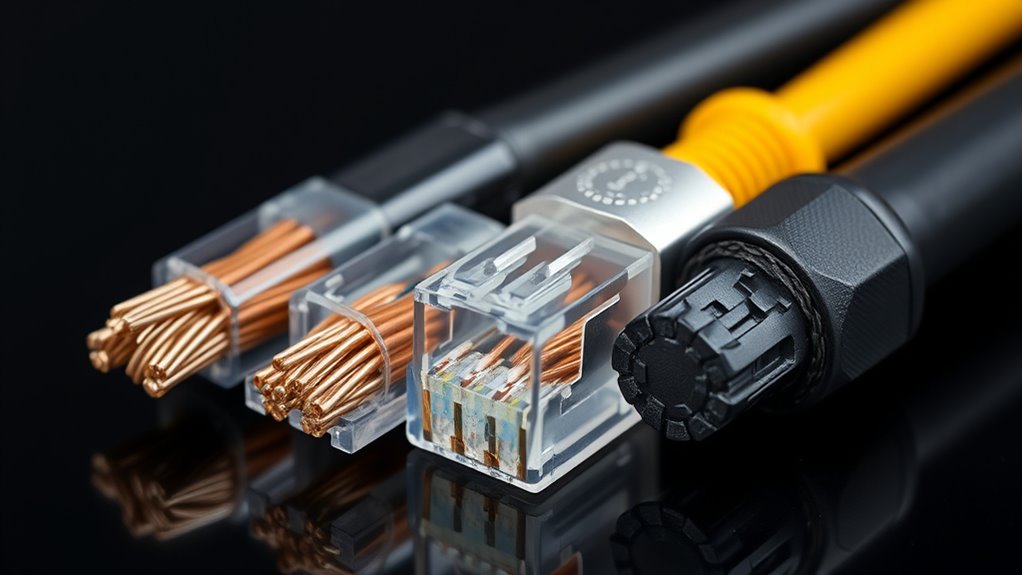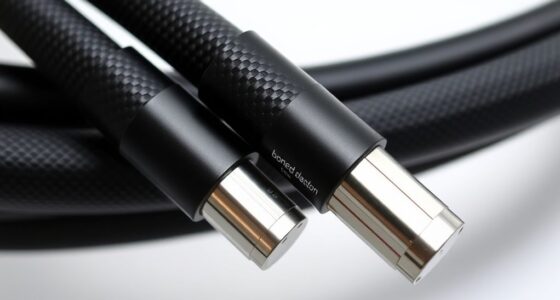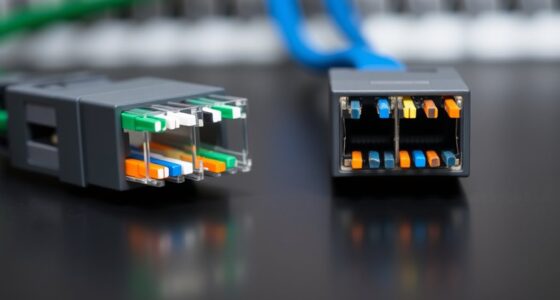Understanding cable shielding types like F/UTP, U/FTP, and SF/UTP helps you choose the right Ethernet cable for your environment. F/UTP has a foil shield over twisted pairs, offering basic EMI protection ideal for low-interference areas. U/FTP wraps individual pairs with foil and adds an overall shield, providing better interference reduction. SF/UTP uses braided and foil shields for maximum protection, suitable for harsh conditions. To guarantee the best network performance, knowing these differences will guide your selection process.
Key Takeaways
- F/UTP cables have a foil shield over twisted pairs, offering basic EMI protection suitable for low-noise environments.
- U/FTP cables feature individual foil shields around each pair plus an overall foil shield, reducing crosstalk and internal interference.
- SF/UTP cables combine a braided shield with an underlying foil, providing the highest level of external EMI and RFI protection.
- Shielding types directly impact signal quality, network reliability, and suitability for different environments with varying electromagnetic interference levels.
- Proper selection of shielding enhances data integrity, reduces errors, and ensures stable network performance in noisy or industrial settings.

To guarantee peak performance and signal integrity, understanding the different types of cable shielding is essential. When you’re working with network cables, signal interference can be a real challenge, especially in environments filled with electromagnetic noise from devices like routers, fluorescent lights, or heavy machinery. The type of shielding used in your cable plays a vital role in minimizing that interference, ensuring your data remains clear and reliable. Different shielding configurations provide varying levels of shielding effectiveness, so knowing the options helps you choose the right cable for your needs.
Understanding cable shielding types helps protect your network from interference and ensures reliable data transmission.
For example, F/UTP cables, which have a foil shield over the twisted pairs, offer basic protection against electromagnetic interference. The foil acts as a barrier that reflects and blocks external noise, reducing signal interference to some degree. However, since the foil is only over the twisted pairs and not the entire cable, its shielding effectiveness is moderate. These cables are suitable for environments with minimal interference but might struggle in more electrically noisy settings.
Moving up in protection, U/FTP cables feature individual foil shields around each twisted pair, combined with an overall foil shield covering all pairs. This design considerably enhances shielding effectiveness compared to F/UTP cables. Because each pair is shielded separately, they are better at preventing crosstalk and internal interference, which can be just as damaging as external noise. The overall foil adds another layer of defense, making U/FTP cables an excellent choice for office spaces or data centers where electromagnetic interference is more prevalent. You’re less likely to experience degraded signal quality or data loss, even in challenging environments.
Then, you have SF/UTP cables, which incorporate a braided shield over the entire cable along with foil shielding underneath. This configuration provides the highest level of shielding effectiveness among these options. The braided shield offers robust protection against external interference, including radio frequency interference (RFI) and electromagnetic interference (EMI). Its flexibility and durability make it ideal for outdoor or industrial applications where cables are exposed to harsh conditions or high levels of electrical noise. When you use SF/UTP cables, you’re effectively minimizing the risk of signal degradation caused by external interference, ensuring your network maintains high performance. Additionally, the choice of shield type impacts the overall signal quality and reliability of your network connections.
Frequently Asked Questions
How Do Shielding Types Impact Network Speed and Bandwidth?
Shielding types directly impact your network speed and bandwidth by reducing interference, which helps maintain signal integrity. Better shielding, like in U/FTP or SF/UTP cables, minimizes external noise, allowing data to transfer more efficiently. This prevents data loss and delays, ensuring faster, more reliable connections. So, choosing the right shielding type boosts your network’s performance by keeping signals clear and stable, even in noisy environments.
Are There Specific Shielding Types Suitable for Outdoor Installations?
You might think all cables work outdoors, but ironically, some shielding types excel here. For outdoor durability and weather resistance, SF/UTP or U/FTP shields are ideal—they provide robust protection against moisture, UV rays, and temperature fluctuations. F/UTP, while good indoors, isn’t designed for harsh conditions. So, if you want your network to survive the elements, choose shielded cables specifically made for outdoor use.
Can Cable Shielding Types Be Mixed Within a Single Network?
Yes, you can mix shielding configurations within a single network, but you need to guarantee shielding compatibility. When using mixed shielding types, like F/UTP and U/FTP, pay attention to how they connect at junctions to avoid interference issues. Proper grounding and connectors are essential for maintaining signal integrity. Always verify that the different shielding types are compatible to prevent noise and ensure reliable performance across your entire network.
What Maintenance Is Required for Different Shielding Types?
You need to regularly inspect the shielding for signs of degradation and guarantee proper grounding practices are in place. For F/UTP and U/FTP cables, check that grounding connections remain secure to prevent interference. SF/UTP cables require less maintenance but still benefit from periodic visual checks. Proper grounding prevents shielding issues, while monitoring for degradation helps maintain ideal cable performance and reduces potential electromagnetic interference risks.
How Do Shielding Types Affect Cable Flexibility and Installation Ease?
Shielding types markedly shape your cable’s flexibility and installation ease. F/UTP cables are fairly flexible, making them easy to maneuver through tight spaces. U/FTP cables offer a balance of shielding and flexibility, simplifying installation without sacrificing protection. SF/UTP cables tend to be stiffer due to extra shielding, which can challenge flexibility and complicate installation. Choosing the right shielding type helps you manage cable handling with greater ease and efficiency.
Conclusion
By choosing the right cable shielding, you’re gently guiding your network to perform smoothly and reliably. Think of shielding as a quiet protector, quietly shielding your signals from unwanted interference. When you understand the subtle differences, you can make smarter choices without any fuss. In the end, it’s about creating a seamless connection that works quietly in the background, letting you focus on what truly matters—your work, your entertainment, and your peace of mind.









